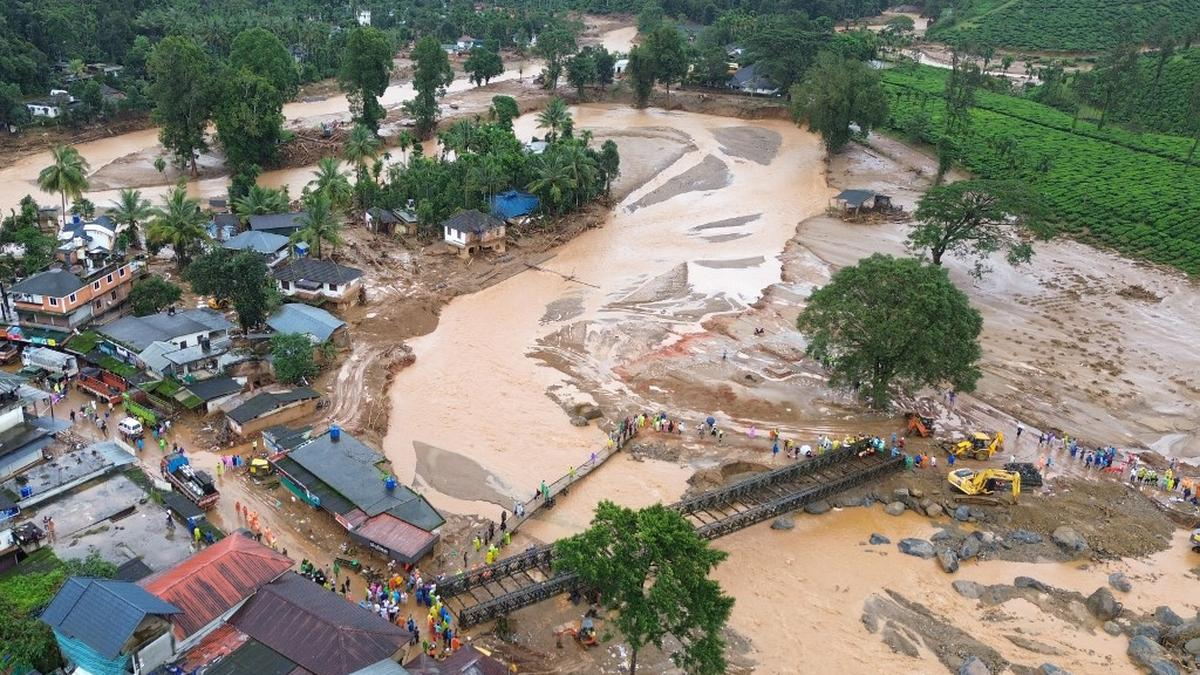
14-08-2024 (Important News Clippings)
To Download Click Here.
Single digits
India needs to broaden its sport base for success in Olympics.
Editorial
India’s return of six medals from the just-concluded Paris Olympics can be termed underwhelming at best. The nation secured one silver and five bronze medals, down from seven at Tokyo 2020 that included a gold and two silvers. At a time when the country is looking to diversify its sporting excellence, has found exuberant support from the government and big corporates, and was aiming for a double-digit medal yield, the Olympic fortnight belied expectations. There were indeed new heroes — shooters Manu Bhaker, Sarabjot Singh and Swapnil Kusale, and wrestler Aman Sehrawat are now household names. The men’s hockey team finishing on the podium for a second straight time and Neeraj Chopra adding a silver to his historic javelin gold from Tokyo are top-notch efforts. But the dependence on a select few to repeatedly deliver, the near-zero presence in disciplines such as swimming and gymnastics, and wrestler Vinesh Phogat being disqualified for being above the weight threshold cast a dark shadow. The need of the hour is thus to broaden the base, increase participation and distribute funding more equitably to usher in a grass-roots revolution. The onus is also on the Union Sports Ministry to bring errant federations — often dens of nepotism and corruption — in line with the National Sports Code, fix accountability and decentralise governance.
As much as the Olympics is about winning and the shaping of national identities, it is also the greatest stage on earth to showcase the triumph of human will. This was best exemplified by the Netherlands’ Sifan Hassan, the first since Emil Zatopek in 1952 to collect medals in 5,000m, 10,000m and marathon, Kenya’s Faith Kipyegon, the first woman to win three consecutive 1,500m titles, Cuba’s Mijain Lopez, who won a fifth individual gold on the trot in 130kg Greco-Roman wrestling, Novak Djokovic, who at 37 and with a surgically repaired knee, won the elusive singles gold in tennis, and Algerian boxer Imane Khelif, who braved incendiary attacks on her gender to rise to the top. Sweden’s Armand Duplantis broke the men’s pole vault record for an astonishing ninth time (6.25m) while swimmer Katie Ledecky, gymnast Simone Biles and hurdler Sydney McLaughlin-Levrone achieved transcendence by stretching their numbers to nine, seven and four Olympic golds, respectively. France did well as a host, winning 16 golds, its best figures in a century. The star was 22-year-old swimmer Leon Marchand, who bagged four golds to position himself as the best of this generation. Athletics, in the post-Usain Bolt era, was on the lookout for one such champion, but as Paris proved, that is a tough act to follow.
Date: 14-08-24
The problem of landslides in Kerala
Reports and recommendations are aplenty, but implementation is tardy.
S. Anandan

This is a tragedy of epic proportions for Kerala, which has been battered by extreme weather events ever since the great flood of 2018. That year, 341 major landslides were reported in the State. Landslides have become a major hazard every monsoon since then, with Wayanad, Idukki, Malappuram, Kasaragod, and Kozhikode districts marked as, and proving to be, highly susceptible to deadly landslides. About 75 people died in overnight landslides at Kavalappara in Malappuram and Puthumala in Wayanad, situated six kilometres apart across the hills, in 2019. Puthumala is barely a few kilometres down the hill from the Chooralmala and Mundakkai wards of Meppadi panchayat, which bore the brunt of the landslides on July 30 this year.
As in 2019, the landslides this year were also triggered by extremely heavy rainfall: 527 mm of rain in 48 hours. It is evident now that there was inadequate early warning. But the role of anthropogenic factors in exacerbating the disaster cannot be discounted.
The Kerala government embarked on a mission to rebuild the State in the wake of the 2018 flood. The post-disaster needs assessment report envisioned a climate-resilient Kerala, which was to be built by managing integrated water resources, following an eco sensitive and risk-informed land use and settlement approach, promoting community-based disaster management, and integrating disaster risk reduction plans across sectors with technology and innovation. However, implementation has been tardy.
The ‘room for river’ project for flood management in the plains has not made any headway. Affirmative action to ensure eco sensitive land use remains a chimera, with the government biding time and a vast majority of the people opposed to the idea of resettlement due to a deep distrust of the system. Unregulated constructions continue to be a menace on the fragile hills in Wayanad and Idukki, with an eye on revenue from tourism. The India Meteorological Department and the Geological Survey of India have delayed upscaling their technical capabilities to give accurate, actionable, and timely early warnings. A case in point is the endless wait for the installation of a Doppler weather radar in Kozhikode to bring north Kerala, including Wayanad, under coverage. Such a radar can give ‘people-friendly’ information such as probable rainfall intensity, wind shear, and the probability of extreme weather such as a cloudburst. But this appears to be a tall order as Wayanad does not even have an adequate number of rain gauges.
But the government has brought local bodies on board the disaster risk reduction matrix. As many as 260 local bodies were handheld by the Kerala Institute of Local Administration in putting together panchayat-level disaster management plans after some laborious fieldwork. Each report contains the whole gamut of information pertaining to that panchayat. For instance, Meppadi, ravaged by the landslides in July, has published a report. To what extent this has been useful in fighting the disaster needs to be examined.
Nevertheless, the plan is sweeping in its coverage of the geomorphological features of the land, the people, the interventions on land, crops, safe routes, etc. It identifies the vulnerable spots and people, such as the differently abled, the bedridden, children, the aged, migrant workers, and those under palliative care. There are long lists of people to sound warnings and be the first responders in the event of a disaster. Officials say these panchayats have been given downscaled climate projection data and maps. For panchayat officials to make sense of the downscaled climate project data and maps, there is a need to ground truth the same.
While the disaster management plan should be frequently updated, experts point to the need to integrate these individual plans while preparing district disaster management plans. There is now a fairly sound understanding of which areas are prone to disasters. While the government should urge the Central agencies to upgrade their systems in order to be able to provide accurate and timely weather alerts, it should also pay attention to community-driven climate monitoring systems.
सरकारें सटीक डेटा के बिना योजनाएं नहीं बना सकती हैं
चेतन भगत, ( अंग्रेजी के उपन्यासकार )

जातिगत जनगणना के पक्ष और विपक्ष में बौद्धिक तर्क हो सकते हैं, लेकिन इसमें भला किसे संदेह होगा कि यह मूल रूप से राजनीतिक मुद्दा है। देश में जातिगत परिदृश्य को बेहतर ढंग से समझें तो न केवल यह पता लगाना जरूरी है कि किसी खास जाति के कितने लोग हैं, बल्कि उनकी सामाजिक-आर्थिक स्थिति के बारे में मालूम करना भी उतना ही आवश्यक है। उदाहरण के लिए, कितने लोगों के पास कारें हैं? कितनों के पास दोपहिया वाहन हैं? वे किस स्तर की शिक्षा प्राप्त कर रहे हैं? वे कहां और कैसे घरों में रहते हैं? उनकी औसत आयु क्या है? ऐसे सवालों के जवाब बेहद मूल्यवान डेटा को सामने लाएंगे। यह डेटा आरक्षण सहित विभिन्न जाति-आधारित कल्याणकारी उपायों में प्रबंधन में मदद करेगा। भारत अभी भी सीमित संसाधनों वाला एक कम आय वर्ग का देश है। फिर भी, हम जो कुछ भी हमारे पास है, उसी के साथ संसाधनों को वंचित वर्गों में पुनर्वितरित करने और अपनी ऐतिहासिक गलतियों को सुधारने का प्रयास करते हैं। लेकिन अगर हमारे मौजूदा उपाय पुराने डेटा पर आधारित होंगे, तो बहुत सम्भव है कि हम अपने संसाधनों को बर्बाद कर रहे होंगे, क्योंकि तब हम वांछित समुदायों तक लाभ नहीं पहुंचा पाएंगे।
हम ऐसे समय में रह रहे हैं, जहां डेटा का उपयोग हर चीज को अनुकूलित करने के लिए किया जाता है। ऐसे में राष्ट्रीय स्तर पर कल्याणकारी योजनाओं को लागू करने के लिए भी सटीक डेटा होना बहुत जरूरी है।
जातिगत जनगणना के कुछ नुकसान भी हैं। सबसे बड़ा नुकसान यह है कि ये तमाम कवायदें अंततः जाति-व्यवस्था को जीवित रखती हैं। एक समाज के रूप में हमारा अंतिम लक्ष्य क्या होना चाहिए? अधिकतम आरक्षण प्राप्त करना? या एक ऐसा समाज बनाना, जहां कोई जातियां नहीं होंगी? इन सवालों के जवाब आसान नहीं। लेकिन यह साफ है कि जब तक जाति-आधारित आरक्षण मौजूद है, तब तक जाति-आधारित सामाजिक-आर्थिक डेटा का होना भी जरूरी है।
लेकिन ये सब तो तार्किक बातें हुईं। अंतिम निष्कर्ष में तो यह कवायद राजनीति के लिए ही है। जैसे राम मंदिर और अनुच्छेद 370 के मुद्दों ने हिंदू वोटों को मजबूत करने में मदद की है, उसी तरह जातिगत जनगणना हिंदू वोटों में सेंध लगाने की जुगत है। जब जातिगत जनगणना के आंकड़े आखिरकार जारी किए जाएंगे, तो विभिन्न जातियों और समुदायों के बारे में पुख्ता जानकारियां सामने आएंगी। कुछ उम्मीद से बेहतर प्रदर्शन कर सकते हैं (जो कि होना भी चाहिए, खासकर अगर आरक्षण कारगर रहा हो तो)। वहीं कुछ अन्य का प्रदर्शन खराब हो सकता है।
डेटा हमेशा नीतिगत फेरबदल की ओर इशारा करेगा, जिसका मतलब है कुछ जातियों को फायदा होगा और कुछ को नुकसान। व्यापक स्तर पर, इसका मतलब यह हो सकता है कि हमारे पास और अधिक आरक्षण होगा, जो उच्च जातियों को परेशान करेगा। या हमें कुछ ऐसी निचली जातियों के बारे में भी पता चल सकता है, जो शायद कुछ उच्च जातियों से बेहतर प्रदर्शन कर रही हों। यह सब चर्चाओं, बहसों, भ्रम को जन्म देगा। लेकिन इसका अंतिम निष्कर्ष हिंदू वोटों का विभाजन ही है और यही कारण है कि भाजपा इससे अचकचा रही है।
रोजगार के अवसर बढ़ाने की चुनौती
गौरव वल्लभ, ( लेखक आर्थिक मामलों के विशेषज्ञ एवं भाजपा नेता हैं )
रोजगार सृजन एक ऐसी चुनौती है, जिससे दुनिया के लगभग सभी देश जूझ रहे हैं। चूंकि भारत दुनिया की सबसे बड़ी आबादी एवं युवाओं वाला देश है तो भारत के लिए यह चुनौती और बड़ी हो जाती है। सरकार इसे भलीभांति समझती है। उसने कुछ प्रयास भी किए हैं। उनके अनुकूल परिणाम भी सामने आए हैं। पीरियोडिक लेबर फोर्स सर्वे से लेकर रिजर्व बैंक, कर्मचारी भविष्य निधि संगठन यानी ईपीएफओ और राष्ट्रीय पेंशन प्रणाली-एनपीएस के समय-समय पर आने वाले आंकड़े इसकी पुष्टि करते हैं। इस उल्लेखनीय तथ्य को भी अनदेखा नहीं किया जा सकता कि युवा वर्ग (15 से 29 आयु वर्ग) में 2017-18 के दौरान जो बेरोजगारी दर 17.8 प्रतिशत थी, वह 2022-23 में घटकर 10 प्रतिशत रह गई। समग्र बेरोजगारी दर भी 2022-23 में अपने निम्नतम पड़ाव 3.2 प्रतिशत पर आ गई। रोजगार के अन्य संकेतक भी सुधार की राह पर हैं। भविष्य निधि में योगदान देने वाले सदस्यों की संख्या 2018 से 20 प्रतिशत से अधिक की चक्रवृद्धि वार्षिक वृद्धि दर से बढ़ने पर है। संगठित क्षेत्र में बढ़ते अवसरों से रोजगारों का औपचारीकरण भी हो रहा है।
इसके बावजूद अभी और प्रयास करने की आवश्यकता है, क्योंकि 2041 तक भारत में उपलब्ध कामकाजी आबादी का स्तर चरम पर पहुंच जाएगा। इतनी बड़ी आबादी के लिए रोजगार के अवसर सृजित करना आसान तो नहीं, लेकिन आसान बनाया जा सकता है। इसके लिए कुछ उपाय करने होंगे। सबसे पहले तो यह सुनिश्चित करना है कि हर साल कार्यबल में शामिल होने वाले युवाओं की बड़ी संख्या को खपाने के लिए पर्याप्त नौकरियां पैदा की जाएं और दूसरा यह कि युवा जो नौकरी पाना चाहते हैं, क्या वे उसके लिए आवश्यक कौशल से लैस हैं भी या नहीं? केंद्र सरकार इन दोनों पहलुओं के समाधान की दिशा में प्रयासरत है। इसका आभास हालिया बजट से भी मिला। बजट में कौशल विकास, रोजगार सृजन और एमएसएमई पर फोकस किया गया। इससे जुड़ी विभिन्न पहल एक मजबूत और समावेशी रोजगार तंत्र को बढ़ावा देने के लिए सरकार के रणनीतिक दृष्टिकोण को दर्शाती हैं। इन कार्यक्रमों में इंटर्नशिप योजना की खासी चर्चा है, जिसके अंतर्गत युवा स्नातक शीर्ष कंपनियों में इंटर्नशिप के माध्यम से अनुभव हासिल करेंगे।
पांच वर्षों में एक करोड़ युवाओं को कौशल प्रदान करने के लिए तैयार किए गए इस कार्यक्रम में युवाओं को 5,000 रुपये मासिक भत्ता मिलेगा। भत्ते के लिए सरकार प्रति वर्ष 54,000 और आकस्मिक खर्चों के लिए अतिरिक्त 6,000 रुपये भुगतान करेगी। जबकि कंपनियां अपने सीएसआर फंड से 6,000 रुपये वार्षिक योगदान देंगी। प्रशिक्षण की लागत भी कंपनियां ही वहन करेंगी। यह व्यावहारिक अनुभव युवाओं की रोजगार क्षमता और नौकरी के लिए तैयारी को व्यापक एवं सार्थक रूप से बढ़ाने में मददगार होगा। यह एक करोड़ स्किल्ड युवा शक्ति देश के 6.4 करोड़ एमएसएमई उद्योगों के लिए प्रशिक्षित जनशक्ति के पूल का भी काम करेगी। हमें यह नहीं भूलना चाहिए कि फिलहाल कुल रोजगार प्रदान करने में एमएसएमई की हिस्सेदारी 62 प्रतिशत की है। अन्य उभरती हुई अर्थव्यवस्थाओं में यह आंकड़ा 77 प्रतिशत तक है। एक वर्ष की इंटर्नशिप पूरी करने के बाद पहली बार नौकरी चाहने वाला युवा स्कीम ए के माध्यम से कार्यबल में प्रवेश कर सकता है। उन्हें तीन किस्तों में वितरित 15,000 रुपये तक की सब्सिडी सरकार द्वारा प्रदान की जाएगी। यह पहल युवा प्रतिभाओं को संगठित क्षेत्र से जोड़ेगी। इससे अनौपचारिक नौकरियों पर निर्भरता कम होगी, जिनमें अस्थिरता और अनिश्चितता कहीं ज्यादा होती है। इसी कड़ी में स्कीम बी के तहत विनिर्माण कंपनियों को जोड़ा गया है। यह योजना विनिर्माण क्षेत्र में रोजगार सृजन को लक्षित करती है, जो नियोक्ता और कर्मचारियों दोनों को वित्तीय प्रोत्साहन देती है। चार वर्षों के संरचित प्रोत्साहन वाली इस योजना में सरकार द्वारा प्रदान किया जाने वाला लाभ नियोक्ता और कर्मचारी के बीच समान रूप से साझा किया जाएगा। यह योजना भी अल्पकालिक भर्ती के बजाय निरंतर एवं स्थायी रोजगार को बढ़ावा देने वाली है। इस योजना का लाभ प्राप्त करने के लिए नियोक्ताओं को कम से कम 50 नए कर्मचारियों या पिछले वर्ष के ईपीएफओ-नामांकित कर्मचारियों के 25 प्रतिशत, इनमें जो भी कम हो, को नियुक्त करना होगा।
इसी तरह, स्कीम सी नियोक्ताओं को और अधिक समर्थन देने के लिए नियुक्त किए गए प्रत्येक अतिरिक्त कर्मचारी के लिए उनके ईपीएफओ योगदान में दो साल के लिए प्रति माह 3,000 रुपये तक का योगदान देगी। नियोक्ताओं के लिए अधिक कर्मचारियों को नियुक्त करना आर्थिक रूप से व्यवहार्य बनाने वाली यह योजना विभिन्न क्षेत्रों में रोजगार वृद्धि को बढ़ावा देगी। इससे अर्थव्यवस्था में चक्रीय प्रभाव उत्पन्न होगा। इनसे जहां उपभोक्ता खर्च बढ़ेगा, वहीं आर्थिक गतिविधियों में तेजी आएगी और नौकरियां सृजित होंगी। चूंकि रोजगार सृजन में कौशल विकास एक अहम कड़ी है तो सरकार ने इस ओर भी पर्याप्त ध्यान देने का प्रयास किया है। ऐसे प्रयासों के अंतर्गत राज्य सरकारों और उद्योग जगत के सहयोग से 1,000 औद्योगिक प्रशिक्षण संस्थानों यानी आइटीआइ का उन्नयन यह सुनिश्चित करेगा कि कामकाजी आबादी को नई जरूरतों के अनुरूप तराशा जाए। पांच वर्षों के दौरान 60,000 करोड़ रुपये की यह योजना पहल परिणाम-आधारित शिक्षा और उद्योग-विशिष्ट कौशल पर केंद्रित है।
स्पष्ट है कि इंटर्नशिप, वेतन सब्सिडी, नियोक्ता प्रोत्साहन और निरंतर रोजगार सृजन सहित एक व्यापक मॉडल के माध्यम से सरकार रोजगार आकांक्षियों और नियोक्ता दोनों पक्षों के बीच संतुलन साधने की दिशा में आगे बढ़ रही है। इससे रोजगार टिकाऊ और उनकी प्रकृति संगठित स्वरूप वाली होगी। ये उपाय रोजगार चुनौतियों का समाधान करते हुए लाखों भारतीयों की आकांक्षाओं की पूर्ति में सहायक बनकर एक समृद्ध और समावेशी अर्थव्यवस्था का मार्ग प्रशस्त करते हैं।
